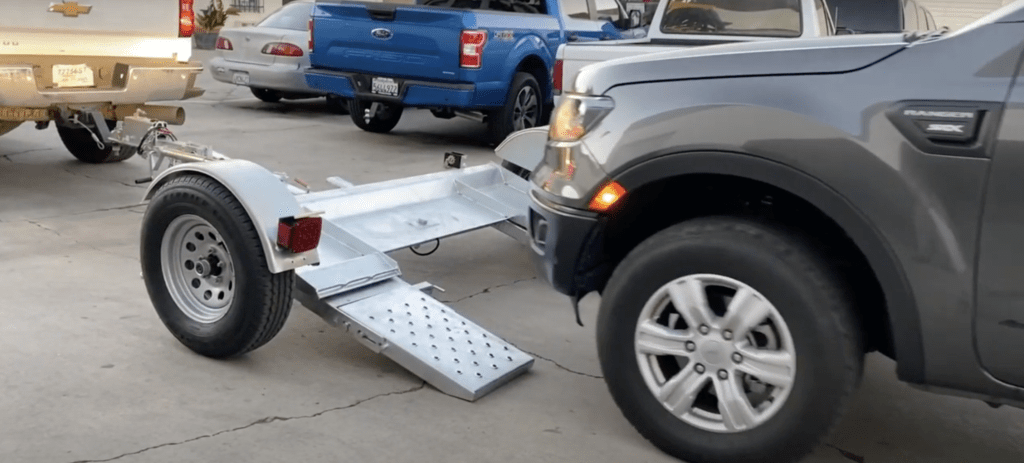To tow a front-wheel drive car, you will need a tow dolly or a flatbed tow truck. The process involves securely attaching the car to the towing vehicle and ensuring that the front wheels are off the ground and not in contact with the road.
Introduction (120 words):Towing a front-wheel drive car requires careful preparation and the right equipment to ensure a safe and successful journey. Whether you’re moving or need to transport your vehicle for repairs, knowing how to properly tow a front-wheel drive car is essential.
In this guide, we will provide you with the step-by-step process and necessary tools to tow your car safely and effectively. By following these instructions, you can avoid causing damage to your car’s drivetrain and ensure a worry-free towing experience. So, let’s get started and learn the correct method to tow a front-wheel drive car that will provide peace of mind throughout the entire process.

Credit: geyerstowing.com
Preparing To Tow A Front Wheel Drive Car
If you find yourself in a situation where you need to tow a front wheel drive car, it’s important to be well-prepared to ensure a smooth and safe towing process. By following a few simple steps, you can ensure that your car is ready to be towed without causing any damage or complications. In this guide, we will walk you through the process of preparing to tow a front wheel drive car, from checking the owner’s manual to gathering the necessary equipment and inspecting the car for towing compatibility.
Checking The Owner’s Manual
Before embarking on the towing process, it’s crucial to carefully review the owner’s manual of the front wheel drive car that you intend to tow. The owner’s manual typically provides detailed instructions and guidelines on whether or not the vehicle is towable and if any specific procedures need to be followed. Look for information regarding the maximum towing speed and distance, any necessary modifications or precautions, and any specific towing equipment that may be required.
Gathering The Necessary Equipment
Once you have familiarized yourself with the requirements outlined in the owner’s manual, the next step is to gather all the necessary towing equipment. This will vary depending on the specific towing method you plan to use. If you are using a tow dolly, you will need the dolly itself along with the necessary straps and safety chains to secure the vehicle. If you are using a tow bar, make sure you have a compatible tow bar and base plate that is specifically designed for your front wheel drive car. Additionally, don’t forget to ensure that your towing vehicle is equipped with the necessary towing hitch and electrical connections.
Inspecting The Car For Towing Compatibility
Before towing your front wheel drive car, it’s important to inspect it thoroughly to ensure that it is compatible with the chosen towing method and that there are no existing issues that could cause further damage during towing. Start by checking the tires for any signs of wear or damage, and make sure they are properly inflated. Examine the suspension, brakes, and steering components to ensure that they are in good working condition. It’s also a good idea to inspect the engine, transmission, and drivetrain for any leaks or mechanical issues that may need immediate attention.
Take a moment to double-check that all the doors, windows, and the trunk are securely closed and latched. Remove any personal belongings and ensure that the car is empty, as excess weight can affect the towing process and potentially cause damage. Finally, make sure that the front wheels are pointing straight ahead, as this will minimize stress on the steering components during towing.
By carefully following these steps and adhering to the recommendations outlined in the owner’s manual, you can ensure that you are well-prepared to tow a front wheel drive car. Remember to always prioritize safety and double-check all connections and equipment before hitting the road. With the proper preparation and attention to detail, you can confidently tow your front wheel drive car without any hiccups.
Towing A Front Wheel Drive Car
Towing a front-wheel drive car requires special attention to avoid transmission damage. Follow these steps to safely tow a front-wheel drive vehicle: ensure the car is properly secured on the tow dolly, release the parking brake, place the transmission in neutral, and drive at a moderate speed to prevent strain on the vehicle.
Choosing The Right Towing Method
When it comes to towing a front wheel drive car, choosing the right towing method is crucial. There are two common methods that you can use to safely tow your vehicle: using a tow bar or using a tow dolly.
A tow bar is a device that connects the front end of your car to the back end of the towing vehicle. This method is ideal if you have a car with a manual transmission, as it allows all the car’s wheels to roll freely. On the other hand, a tow dolly is a small trailer-like device that lifts the front wheels of the towed car off the ground, allowing the back wheels to roll freely. This method is more suitable for cars with an automatic transmission or if you prefer not to disconnect the drive shaft of your front wheel drive car.
Attaching The Tow Bar Or Dolly
Once you have decided on the towing method that suits your car and preferences, it’s time to attach the tow bar or dolly. To attach a tow bar, you need to ensure that it is securely connected to both vehicles. Start by attaching the tow bar to the towing vehicle’s hitch receiver, making sure to follow the manufacturer’s instructions. Then, attach the other end of the tow bar to the front end of your car, using a mounting bracket specific to your vehicle’s make and model.
If you opt for a tow dolly, you need to position your car on the dolly and secure it with straps or chains. Make sure to follow the manufacturer’s instructions and secure the car tightly to prevent any movement during transportation.
Securing The Car For Towing
Before you start towing, it’s important to secure your front wheel drive car properly to ensure a safe journey. Begin by double-checking that all attachments, such as the tow bar or dolly, are securely fastened. This step is crucial to prevent any mishaps while on the road.
In addition to securing the attachments, you should also consider securing the car’s wheels. If you are using a tow bar, you can use wheel nets or tire straps to secure the front wheels of the towed car. This helps to prevent any unwanted movement of the front wheels during towing. For a tow dolly, make sure to tighten the straps or chains that secure the car’s tires on the dolly, ensuring a tight and secure fit.
Moreover, don’t forget to attach safety chains between the towing vehicle and the car being towed. These chains act as a backup in case any of the attachments fail, providing an extra layer of security and preventing the towed car from completely detaching from the towing vehicle.
In conclusion, towing a front wheel drive car requires the use of the right towing method and proper attachment and securing techniques. By carefully following the steps outlined above, you can confidently tow your car to your desired destination, knowing that it is safe and secure throughout the journey.
Safety Tips For Towing A Front Wheel Drive Car
When it comes to towing a front wheel drive car, ensuring the safety of both the towed vehicle and yourself is essential. Understanding weight distribution, driving cautiously while towing, and regularly checking connections and brakes are all crucial aspects to consider. By adhering to these safety tips, you can have a smooth and secure towing experience.
Understanding Weight Distribution
Proper weight distribution is vital when towing a front wheel drive car to ensure stability on the road. The majority of the weight should be positioned towards the front of the towing vehicle. This helps maintain control during acceleration, braking, and turning.
When preparing to tow a front wheel drive car, consider using a weight distribution hitch. This device helps evenly distribute the weight between the towing vehicle’s front and rear axles, improving stability and control.
Driving Cautiously While Towing
Driving cautiously is of utmost importance when towing a front wheel drive car. The additional weight and altered handling characteristics can affect the towing vehicle’s stability and braking distance. Follow these tips to drive safely:
- Maintain a safe distance between your vehicle and the one you are towing, allowing enough room for sudden stops.
- Accelerate slowly and steadily, avoiding rapid acceleration that can strain the towed car.
- Use gentle and gradual braking to prevent skidding or jackknifing.
- Take wider turns to accommodate the extended length of the towing combination.
- Keep an eye on your mirrors to monitor the stability of the towed vehicle throughout the journey.
Regularly Checking Connections And Brakes
To ensure a safe towing experience, it is crucial to regularly check the connections and brakes of both the towing and towed vehicles. Prior to each trip, carefully inspect the following:
| Connections | Brakes |
|---|---|
|
|
By regularly inspecting and maintaining these connections and brakes, you can minimize the risk of accidents or equipment failure while towing.

Credit: auto.howstuffworks.com

Credit: www.shipvehicles.com
Conclusion
To conclude, towing a front-wheel drive car requires proper planning and execution to ensure the safety of both the vehicle and the towing process. By following the steps discussed in this blog post, you can confidently tow your front-wheel drive car without causing any damage.
Remember to always use the right equipment, maintain a safe speed, and consult with professionals if you have any doubts. With these guidelines in mind, you’ll be well-prepared for any towing situation.


